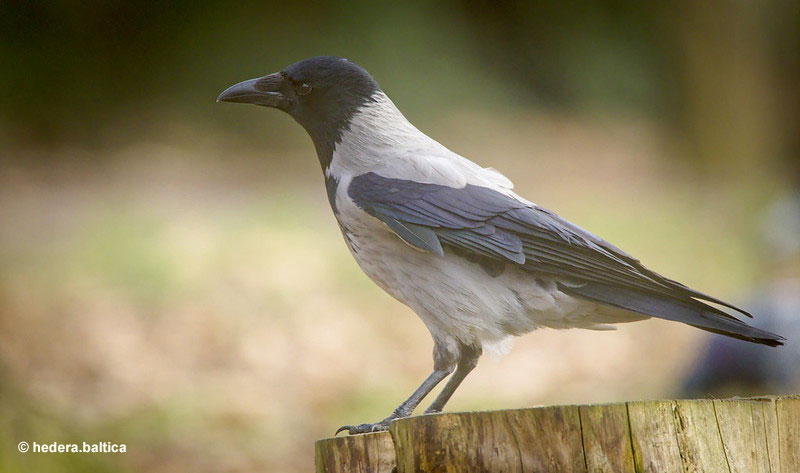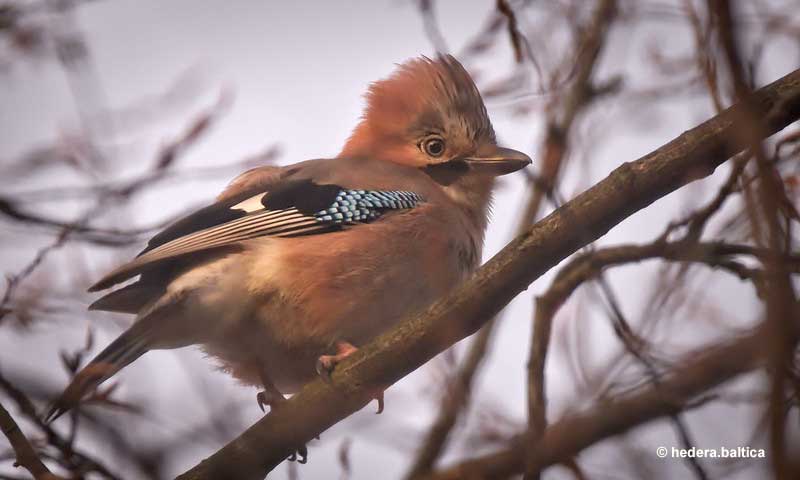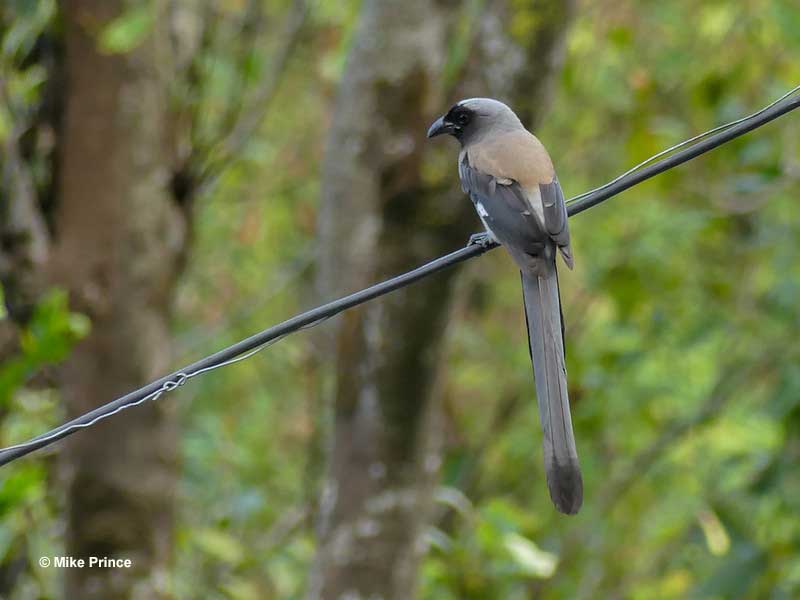
Corvids are fairly common and can be found almost all over the world. They are represented in various folktales and mythology, often associated with death and the supernatural. However, they are not all ominous. Most corvid species are rather social and intelligent albeit a bit mischievous. Let’s meet some of them!
On this page
The Corvid Family
The Corvidae family, encompassing 135 species, including crows, ravens, magpies, jays, and nutcrackers, constitutes a diverse group of medium to large-sized passerine birds.
Learn more: Bird classifications & families
These birds are characterized by robust builds, strong bills and feet, and predominantly black or blue plumage among temperate zone species. Fossil records indicate that they have existed at least since the mid-Miocene, which was around 17 million years ago.
Corvids can be found all around the globe and are absent only from the polar ice caps and the southern tip of South America.
They are predominantly omnivorous and display remarkable intelligence comparable to non-human great apes, even exhibiting self-awareness and tool-making capabilities. Mutual aid and social play are common, and they often have complex hierarchies.
Most corvid species are not currently threatened primarily due to their remarkable adaptability to a wide range of environments, including those altered by human activities.
They have shown a capacity to thrive in urban, suburban, and agricultural landscapes, often taking advantage of food and other resources provided by humans. On the other hand, certain factors like habitat loss or persecution can still pose localized threats to specific corvid species.
American Crow

Scientific name: Corvus brachyrhynchos
Location: North America
Habitat: Various semi-open habitats, including farms, fields, shores, woodlands, and urban and suburban areas.
The American Crow is a highly intelligent and adaptable member of the corvid family. Physically, they are large, all-black birds with a robust build, strong legs and feet, and a distinctive hoarse cawing call. They are similar in appearance to the Common Raven but are generally smaller with a less pointed beak and tail.
What makes American Crows unique is their exceptional intelligence and problem-solving abilities. Studies have shown they can remember the faces of individual humans, hold grudges against those who have wronged them and even teach other crows to identify and avoid specific people. They are also known to use tools, engage in complex social behaviors, and have diverse vocalizations with regional dialects.
The social behavior of American Crows parallels certain aspects of human society. They are monogamous, form strong family bonds, and young crows of one to two years old often help raise their parents’ new offspring. When one of them dies, they often hold ‘funerals’ and try to determine the cause of their companion’s demise.
Common Raven
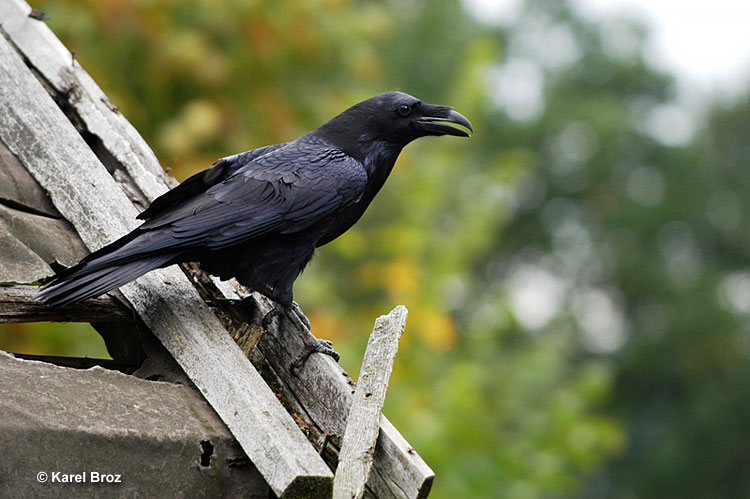
Scientific name: Corvus corax
Location: North America, Europe, Asia, and parts of northern Africa.
Habitat: Often in forested areas from tundra to mountains to deserts. May live in more open areas provided there are good nesting sites.
Common Ravens are large, all-black birds. They are often associated with death, bad omens, and the otherworld. Some European cultures believed that they were evil incarnate!
However, they are generally just intelligent and mischievous, sometimes wreaking a tiny bit of havoc. This can come in the form of causing power outages by contaminating power line insulators, pecking holes in airplane wings, or opening campers’ tents.
But all of that intelligence is not always wasted on creating chaos. They can imitate human words, mimic the calls of other birds, and use gestures to communicate.
Ravens also engage in ‘anting’, a behavior where they rub ants on their feathers or lie in anthills. While the scientific reason behind this behavior is not known, theories range from the ants acting as insecticide or fungicide to ant secretion acting as a soothing agent.
When it comes to the social aspect, then Common Ravens mate for life, forming pairs that defend fixed territory throughout the year. When young birds leave home, they form ‘gangs’ until they find a mate.
Interestingly enough, birds living in those groups have higher stress levels than mated adults. They are also smart and resourceful predators, often hunting in pairs. One distracts the ‘guards’ while the other raids a nest or scavenges for food.
Hooded Crow
Scientific name: Corvus cornix
Location: Mostly Europe, limited parts of western Asia.
Habitat: Woodlands, farmlands, urban and suburban areas.
Hooded Crows are distinctive birds with ashy grey plumage complemented by a black head, throat, wings, thigh feathers, tail, eyes, bill, and feet.
They are omnivorous, consuming a variety of food items from insects and small mammals to fruits and seeds to carrion. One notable behavior is their method of handling hard-shelled prey like mollusks and crabs. They are known to drop these prey items from a height to crack them open and access the tasty inside.
Hooded Crows are highly social birds, often seen in family groups and small gangs. They mate for life and work together to defend their territory. Birds from adjacent territories cooperate in chasing away larger predators.
Hooded crows are remarkably intelligent, with cognitive abilities on par with some great apes. They can use tools and solve complex problems. Despite their sometimes negative reputation, hooded crows play an important ecological role as scavengers, helping to remove animal carcasses that could pose health hazards.
Fish Crow
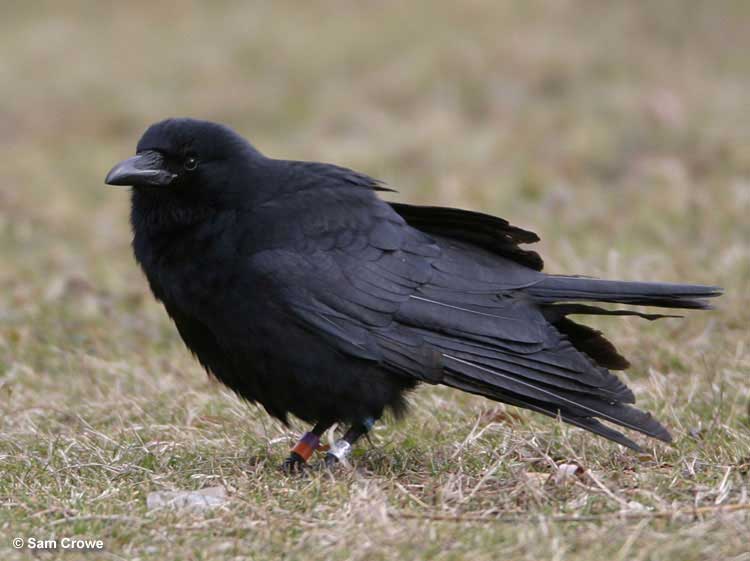
Scientific name: Corvus ossifragus
Location: North America
Habitat: Mostly found along the southeastern coast on beaches, estuaries, and marshes. Also farmlands and woodlands. Often found near water.
Fish Crows are a species primarily found along the eastern coast of the United States, but they have been expanding their range northward in recent years. They are all-black and very similar to the American Crow but are noticeably smaller.
These crows are opportunistic omnivores with a focus on aquatic prey, hence the name. Their scientific name ossifragus translates to bone-breaker. The birds often hover and use their feet to pluck food items from shallow waters or the ground.
However, what makes them so interesting is their adaptability, intelligence, and social behaviors. They are social birds, often joining forces with other corvids to drive away predators and other intruders. Young crows often play with new objects and sometimes even hang upside down from branches and swing. One pair adopted a young Blue Jay and raised it for two weeks.
Rook
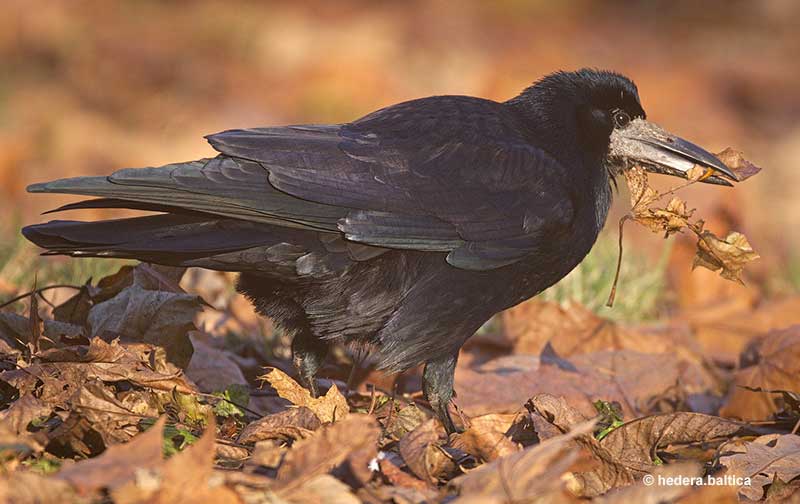
Scientific name: Corvus frugilegus
Location: Europe, Asia.
Habitat: Lowlands, open agricultural areas with tall trees. Also smaller towns and other human settlements.
Rooks are fairly large birds with overall glossy black plumage that shows a bluish sheen in sunlight and black legs and feet. They have a pale bill and a distinctive bare whitish area around the eye and base of the bill, giving the impression of a longer bill.
The species is highly social, often seen in large flocks or nesting colonies known as rookeries. These colonies contribute significantly to changes in soil properties due to the accumulating excrement. They form monogamous pair bonds and support each other in conflicts. In autumn, you may witness impressive synchronized aerial displays including dives and barrel rolls.
While wild Rooks haven’t shown that they use tools, then captive Rooks have demonstrated both problem-solving abilities and tool-use capabilities. They have completed tasks like the trap-tube problem where they have to retrieve rewards while avoiding traps. Rooks may also collaborate to solve problems.
Blue Jay
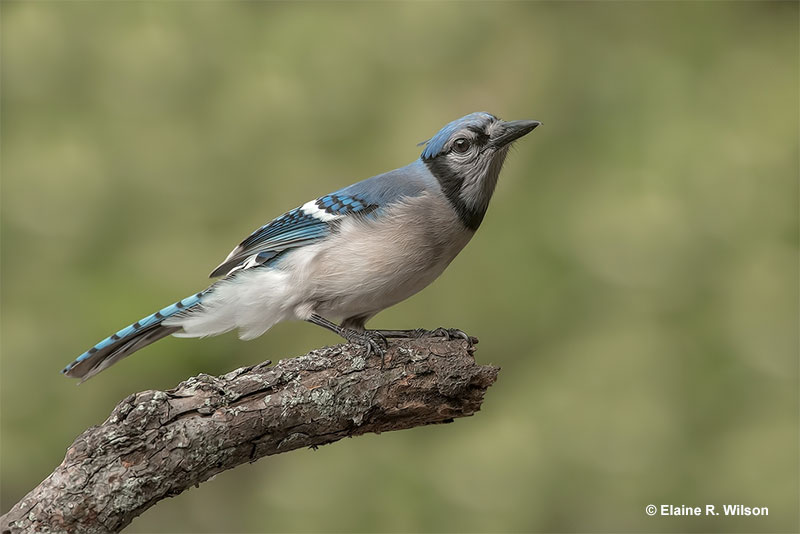
Scientific name: Cyanocitta cristata
Location: North America
Habitat: Mixed or deciduous woodlands, groves, suburban areas, and towns. Favors oak, beech, and pine.
Blue Jays are striking birds with predominantly blue plumage, a white chest and underparts, and a distinctive blue crest atop their heads. They have a black U-shaped collar around their necks, black face markings, and a black nape. These markings are highly variable and possibly aid in recognizing individuals.
Known for their noisy and bold nature, Blue Jays are aggressive towards predators, often mobbing and screaming to deter threats like hawks and owls from their territory. They mimic raptor calls, possibly to deceive or intimidate competitors. Blue Jays are also territorial at feeding sites, chasing away other birds and sometimes preying on smaller species. When agitated, they raise their crests.
These intelligent and curious creatures are also very playful. Young birds especially like to carry around shiny objects like bottle caps. Captive Blue Jays also use tools. Some have even tried to open the doors of their cages!
Steller’s Jay
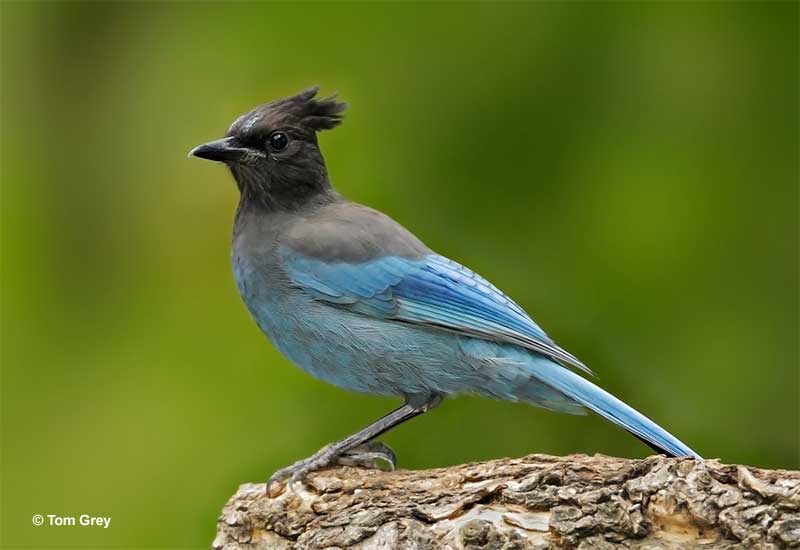
Scientific name: Cyanocitta stelleri
Location: North America
Habitat: Pine-oak and conifer forests during the breeding season, as well as other woodland types, orchards, and well-wooded suburbs during non-breeding season.
The appearance of Steller’s Jays has notable differences based on region and subspecies. Generally, they are fairly dark with rich blue primaries and tail feathers adorned with darker barring. Their heads can range from dark blue to brown or black, often featuring white or bluish markings.
One of their remarkable traits is their exceptional mimicry ability. Steller’s Jays can imitate a wide range of bird species’ vocalizations, other animal sounds, and even non-animal noises. They often mimic the calls of birds of prey as a warning signal or to make other birds flee the feeding area.
Steller’s Jays are also adept at assessing risks using different detection cues. They have distinct alarm calls that vary based on the type of predator and whether the predator was seen or only heard. For example, if a predator is only heard and not seen, then they aren’t as quick to react.
Azure Jay
Scientific name: Cyanocorax caeruleus
Location: South America
Habitat: Atlantic Forest, especially areas with the Parana pine.
The Azure Jay is the largest corvid in South America, measuring 16 inches long, and is the state bird of Paraná. They sport deep blue plumage with a contrasting black head and upper chest. Azure Jays primarily feed on nut-like seeds from the Araucaria pine tree but also consume insects and fruit.
Read more: Endangered birds & can we help them?
These jays are social breeders with a playful nature. They live in groups of four to fifteen individuals and have stable hierarchies. Despite their adaptability and intelligence, their populations are declining. They are listed as near threatened on the IUCN Red List.
Florida Scrub Jay
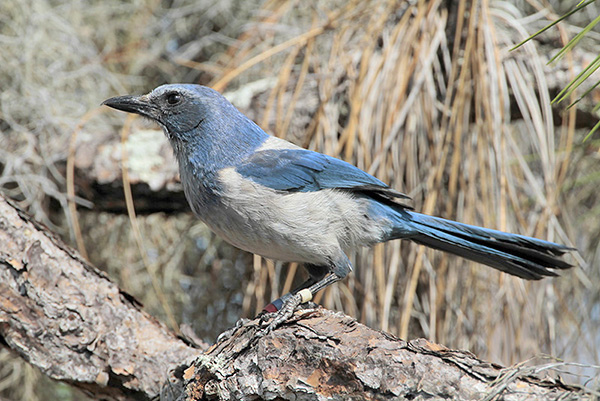
Photograph © Greg Lavaty.
Scientific name: Aphelocoma coerulescens
Location: North America
Habitat: Scrublands (Florida)
The Florida Scrub Jay is a medium-sized corvid with dull blue plumage, a whitish forehead, and a pale gray back and belly.
This species is resident, rarely moving far from their birthplace, and endemic to Florida scrub habitat. With a population of under ten thousand individuals and facing habitat loss, the Florida Scrub Jay is listed as vulnerable on the IUCN Red List.
Habitat fragmentation has further isolated populations, contributing to their vulnerability.
On a brighter note, however, they are family-oriented and cooperative breeders. Offspring stay to help raise the next brood or two before dispersing to create families of their own. Family members take turns acting as sentinels, watching for predators and intruders, and giving alarm calls to signal danger.
Their vocalizations differ based on their geographic location. If a predator is spotted, the family unites to mob them.
Green Jay
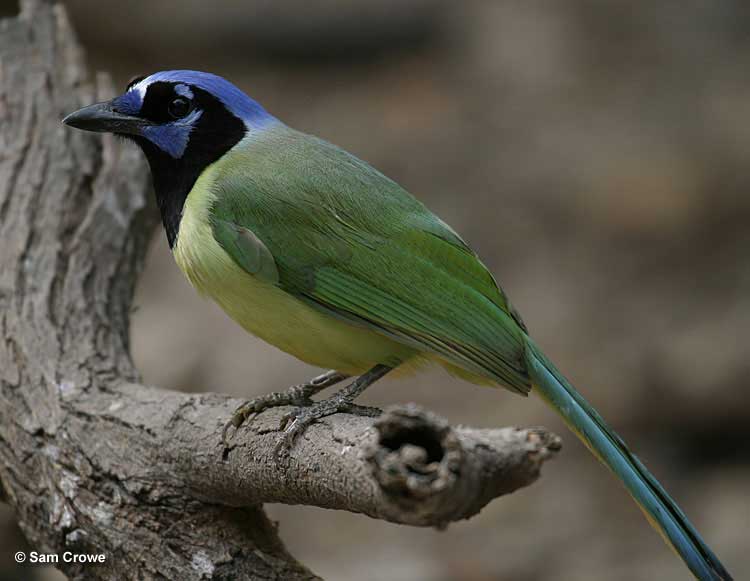
Scientific name: Cyanocorax luxuosus
Location: North America and South America
Habitat: Woodlands, mesquite brush, some suburban areas with native vegetation. In Central and South America also humid forests, foothills, and lower mountain slopes.
Green Jays are delightfully colorful. They are rich green above, pale yellowish below, have a blue crown, a black throat and face pattern, and yellow outer tail feathers. The taxonomy of the species, however, is a bit murky.
Birds in Central and South America differ in color, calls, and even behavior, leading some to believe that they are different species. On the other hand, some ornithologists propose that Green Jays are conspecific with the Inca Jay of the Andes.
However, let’s put the specifics aside for now. These jays travel in family flocks, gleaning insects from the foliage, pouncing on prey on the ground, and snatching flying ones in mid-air. They are adept mimics and often imitate hawk calls to intimidate other bird species to secure food sources. Young Green Jays remain with their parents for about a year and assist in raising the subsequent clutch.
Eurasian Jay
Scientific name: Garrulus glandarius
Location: Europe, Asia, limited range in northern Africa
Habitat: Mixed woodlands, urban areas. Favors oak.
Eurasian Jays are distinguished by their pinkish-brown plumage with a black stripe on each side of a whitish throat, a bright blue panel on the upper wings, and a black tail. Their extensive range has resulted in several distinct subspecies across Europe and Asia.
Eurasian Jays are renowned mimics, often imitating other bird species with remarkable accuracy. Their own call is a harsh, rasping screech. They are known to take into account their possible future needs. For example, they cache food, particularly acrons. It is so instilled in them that captive birds have resorted to hiding things that look like acorns if there are no real ones.
Eurasian Jays also have various responses to threats. They may freeze and/or emit alarm calls when spotting aerial predators, engage in mobbing, or use mimicry to deceive or intimidate intruders. Jays may quietly sit on nests to avoid detection or assume a defensive pose when the predator is near.
Red-billed Chough
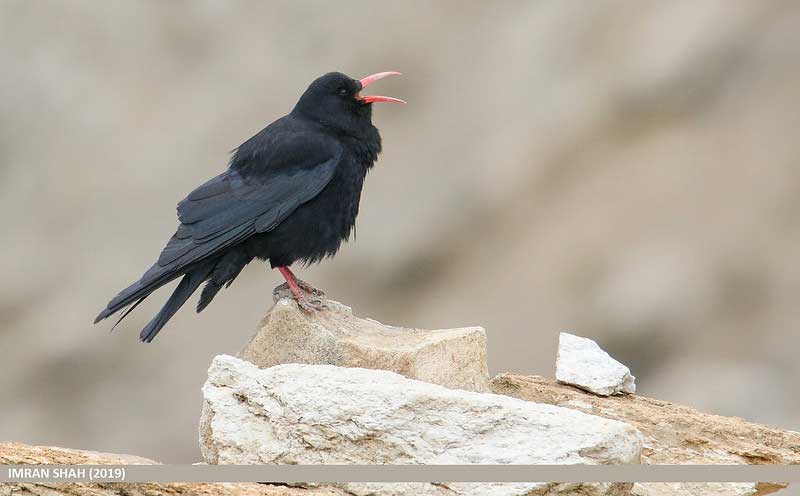
Scientific name: Pyrrhocorax pyrrhocorax
Location: Asia, parts of Europe and Africa
Habitat: High mountains, coastal sea cliffs.
The Red-billed Chough has glossy black plumage, a distinctive long curved red bill, and red legs. It inhabits high mountain regions typically between 6,600 and 9,800 feet but can soar as high as 20,000 to 26,000 feet during the summer.
Historically, they were associated with mischief, accused of stealing various household objects, including lit candles. This led to stories of the birds committing arson.
Red-billed Choughs are monogamous and form lifelong pair bonds, displaying fidelity to their breeding sites. They excavate holes in soft sandstone that can go around three feet deep, or use quarries and mineshafts as nesting sites. The nest is made of sticks and lined with wool or hair for insulation.
Grey Treepie
Scientific name: Dendrocitta formosae
Location: Asia
Habitat: Forests, foothills, human settlements
Grey Treepies are also known as the Himalayan or Asian Treepies. They are medium-sized birds characterized by a blend of grey, black, and brown plumage and a long tail. Subspecies exhibit differences in coloration and tail length, with grayer types resembling Hooded Crows and others showing more brown tones.
Grey Treepies are omnivorous with a diverse diet that includes insects, eggs, nestlings, small reptiles, grains, seeds, and even nectar! You don’t see that in the diet of corvids very often. The treepies are typically found in pairs or small flocks.
Yellow-billed Magpie
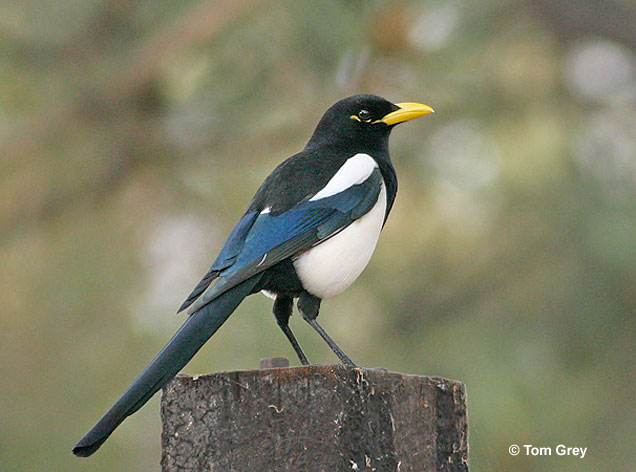
Scientific name: Pica nuttalli
Location: North America (California)
Habitat: Farmland, pastures, riverside groves. Favors oak, sycamore, and cottonwood.
The Yellow-billed Magpie, also known as the California Magpie due to its exclusive presence in California, is a distinctive black-and-white bird with a bright yellow bill. They are highly gregarious and social. When a magpie dies, they hold a funeral-like congregation. Birds gather around the dead body and vocalize for about 10 minutes.
These magpies are opportunistic omnivores, known to peck insects off the backs of mule deer. Unfortunately, they are extremely vulnerable to various illnesses, including the West Nile virus.
This susceptibility, coupled with habitat loss, rodent poison, pesticides, and climate change, has led to a declining population, resulting in their listing as vulnerable on the IUCN Red List.
Black-billed Magpie
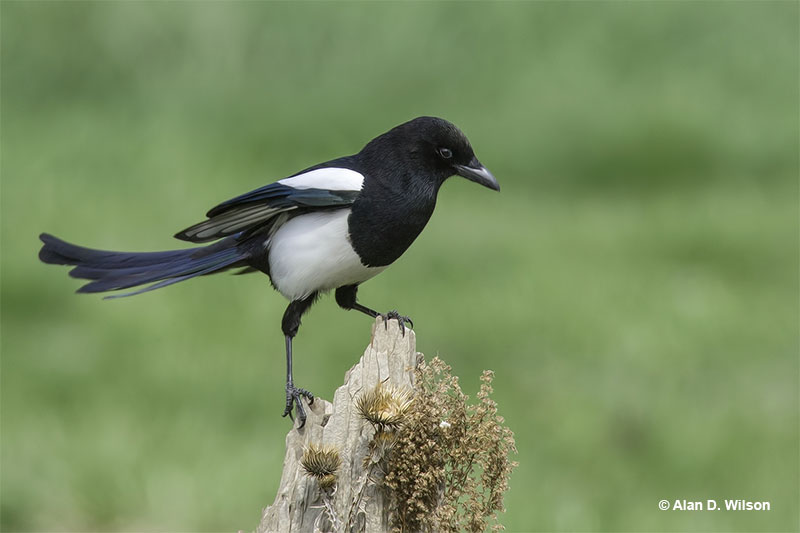
Scientific name: Pica hudsonia
Location: North America
Habitat: Fields, meadows, towns, riparian thickets, farms
The Black-billed Magpie is characterized by its black and white plumage with iridescent blue and blue-green sheen on the wings and tail. Formerly considered a subspecies of the Eurasian Magpie, it was reclassified as a separate species based on genetic evidence. They are known to follow large mammals, especially cattle to glean ticks and insects off of them.
Black-billed Magpies form long-term pair bonds, often for life. They vigorously defend their nests against intruders, sometimes relocating or abandoning the clutch altogether if the disturbance persists.
Interestingly, magpies can recognize individual humans and if that human pesters them or their nesting sites, they may start mobbing that specific human to drive them away.
Contrary to popular belief, magpies do not have a universal attraction to shiny objects. Neither does this one. Studies show that most magpie species are cautious around shiny objects rather than inherently attracted to them.
Clark’s Nutcracker
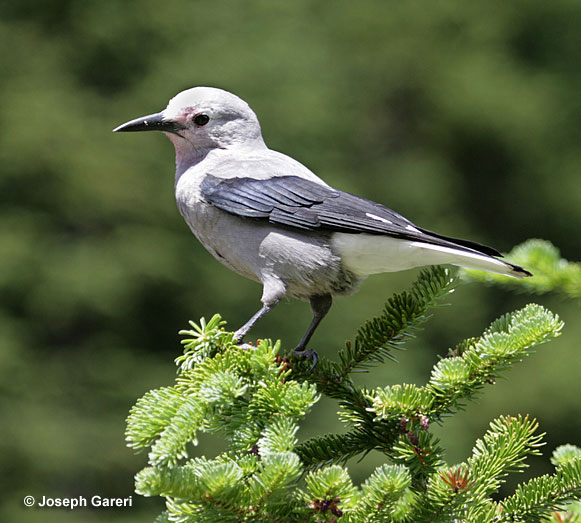
Scientific name: Nucifraga columbiana
Location: North America
Habitat: High mountains, may move above and below the treeline depending on the season. Breeds in conifers.
Clark’s Nutcrackers are light gray with black wings and large white patches along the trailing edges in flight. They are often called woodpecker crows due to their long and straight sharp-tipped bill.
One of the most remarkable aspects of Clark’s Nutcrackers is their specialized pouch under the tongue, capable of holding up to 50–150 pine seeds.
They rely heavily on those for food, caching excess seeds for later consumption.
Nutcrackers can store thousands of seeds per season, also keeping in mind that some of them will be stolen by other species. Although they have exceptional memory and can locate the caches even months later in different conditions, some seeds will still stay in the ground and start to grow. This helps to keep their habitat growing.
Interestingly, Clark’s Nutcrackers defy typical bird incubation roles, with males developing a brood patch and sharing egg incubation duties with females, a behavior uncommon among members of the crow family.
You Might Also Ask
What makes a bird a Corvidae?
Corvids are generally described as robust birds with strong feet and bills and often black or blue iridescent plumage. They are renowned for their exceptional intelligence.
How many members are in the Corvid family?
There are 135 members in the Corvid family.
Are all jays part of the Corvidae family?
Jays belong the the Corvidae family. Although they do not look too similar, it’s easy to see how Blue Jays resemble the crow family.

